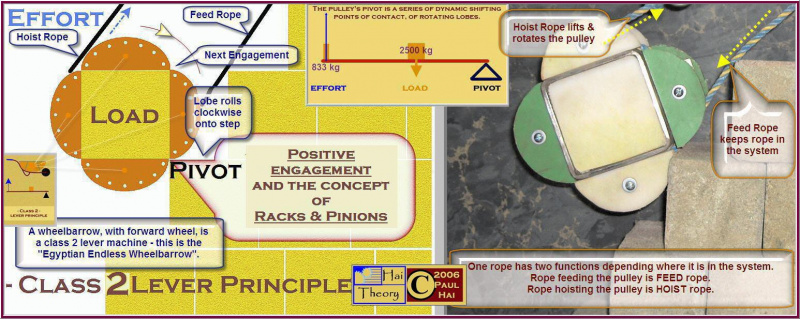File:Wheelbarrow.jpg
The imaqe shows the Shedu four lobe pinion pulley with its load surrounded working on Giza Pyramid steps with a Mechanical Advantage of 2.8 (MA=2.8) There was never any need to construct any type of ramp at Giza for raising Pyramid blocks as a Pyramid under construction provided steps all around and finally over 200 reducing layers of The Great Pyramid resulted in these steps. It can be said Giza Pyramids were designed specifically to be used progressively toward their construction from start to finish.
The engineering logistics of CONSECUTIVE traffic of blocks raised within the documented twenty year time-frame rules out ALL ramp and water-shaft canal theories which all have "one block follows another' illogical approach. Blocks were moved SIMULTANEOUSLY over all those STEPS you see of all Giza Pyramids. Four-lobe pinion-pulleys were used on and over ALL available horizontal STEP surface area. Hoist one block per hour over an eight hour day. Forty pulleys, ten per side, raise 320 blocks.
Over a year, 365 days 116,800 blocks are raised. Over Twenty years 2,336,000 blocks have been raised. The method is known in our modern world as Rack and Pinion mechanical engineering. Those hundreds of limestone STEPS can be termed RACKS. The Pinions were fabricated from imported Lebanese Cedar timber under the supervision of Chief Carpenter Inty Shedu who was entombed on the Giza Plateau. Inty Shedu's four tomb statues are exhibited in the Cairo museum. The Shedu Four-Lobe Pinion-Pulley has an innate mechanical advantage of 2.8 (MA=2.8) which means a 2500kg Pyramid block is raised with an input effort of 900kg. Search haitheory website and haitheory at YouTube.
File history
Click on a date/time to view the file as it appeared at that time.
| Date/Time | Thumbnail | Dimensions | User | Comment | |
|---|---|---|---|---|---|
| current | 02:10, 29 April 2025 |  | 1,546 × 617 (208 KB) | Paul Hai (Talk | contribs) | (The imaqge shows the Shedu four lobe pinion pulley with its load surrounded working on Giza Pyramid steps with a Mechanical Advantage of 2.8 (MA=2.8) There was never any need to construct any type of ramp at Giza for raising Pyramid blocks as a Pyramid un) |
- Edit this file using an external application (See the setup instructions for more information)
File usage
There are no pages that link to this file.
Featured articles and news
Shading for housing, a design guide
A look back at embedding a new culture of shading.
The Architectural Technology Awards
The AT Awards 2025 are open for entries!
ECA Blueprint for Electrification
The 'mosaic of interconnected challenges' and how to deliver the UK’s Transition to Clean Power.
Grenfell Tower Principal Contractor Award notice
Tower repair and maintenance contractor announced as demolition contractor.
Passivhaus social homes benefit from heat pump service
Sixteen new homes designed and built to achieve Passivhaus constructed in Dumfries & Galloway.
CABE Publishes Results of 2025 Building Control Survey
Concern over lack of understanding of how roles have changed since the introduction of the BSA 2022.
British Architectural Sculpture 1851-1951
A rich heritage of decorative and figurative sculpture. Book review.
A programme to tackle the lack of diversity.
Independent Building Control review panel
Five members of the newly established, Grenfell Tower Inquiry recommended, panel appointed.
Welsh Recharging Electrical Skills Charter progresses
ECA progressing on the ‘asks’ of the Recharging Electrical Skills Charter at the Senedd in Wales.
A brief history from 1890s to 2020s.
CIOB and CORBON combine forces
To elevate professional standards in Nigeria’s construction industry.
Amendment to the GB Energy Bill welcomed by ECA
Move prevents nationally-owned energy company from investing in solar panels produced by modern slavery.
Gregor Harvie argues that AI is state-sanctioned theft of IP.
Experimental AI housing target help for councils
Experimental AI could help councils meet housing targets by digitising records.
BSRIA Occupant Wellbeing survey BOW
Occupant satisfaction and wellbeing tool inc. physical environment, indoor facilities, functionality and accessibility.























